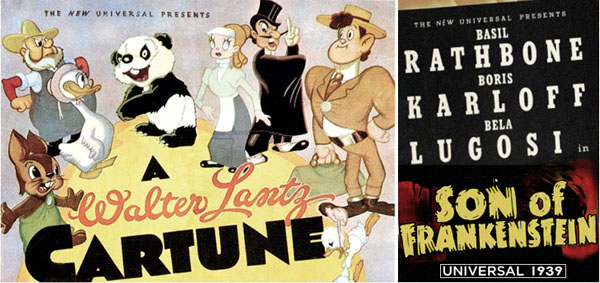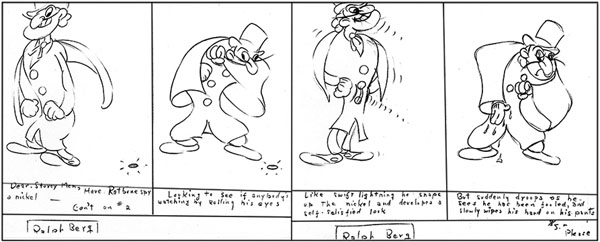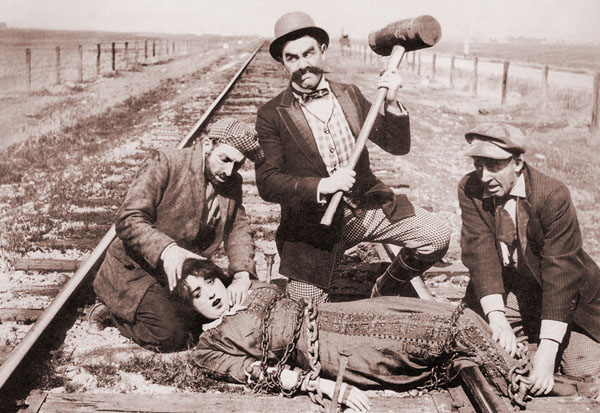
The words knickerbocker, pneumatic, kinetoscope, and monocle all bring to mind a certain decade long ago—the 1890s, when bicycles had huge front wheels and real men had waxed moustaches. To the eight young men working as the Lantz studio’s in-betweeners in 1939, the end of the Victorian era was as distant to them as Atari joysticks seem today.
Yet they did their best providing the in-between frames for an animated series from Walter Lantz that spoofed the sappy melodramas of that bygone time. These starred the character Nellie, with titles like Nellie the Sewing Machine Girl (1938) and The Bird on Nellie’s Hat (1939). They were similar in theme to Chuck Jones’ later The Dover Boys (1942), although filmed in black and white.
Lantz was experimenting with new characters to replace Oswald Rabbit. This Cartune melodrama was just one among several irons-in-the-fire that he hoped would become the next hit series for Universal. After a significant restructuring, the marketing for the studio was all about seeming new. “The New Universal Presents” was the preferred line above the title on its movie posters in 1939.
As it turned out, what panned out for Universal in the late 30s wasn’t always so new. With the release of the box-office hit, Son of Frankenstein, they were dipping back into the same well of monster movies that had brought them success before. And really, has there ever been a more potent gathering of Victorian faces than the three stars of this film? Basil Rathbone, Boris Karloff, and Bela Lugosi—all distinguished for their Old World countenances.
The Lantz animation staff enjoyed seeing the famous actors on the studio lot. Son of Frankenstein was in production just as the Nellie series was starting up and all eyes were on Stage 28 and its monstrous collection of talent. The studio was counting on Basil, Boris, and Bela to deliver. It only made sense for Lantz to invoke Rathbone, with a nod also to Rudolf Valentino, in naming his rakish new cartoon villain: Rudolf Ratbone.

The rivals for Nellie’s attention were the dastardly Rudolf and her wholesome hero, Dauntless Dan. Like The Dover Boys, the series starred the voice talent of Mel Blanc and it lampooned the moral rectitude of the 1890s, a time when entertainment was served up like spoonfuls of castor oil or a preacher’s sermon.
Lantz was born in 1899—though he told everyone 1900, a secret that he corrected only much later in life—so he may have had more affinity for this line of humor than the boys he kept in the “Black Hole,” the windowless room where the animators’ stacks of drawings were sent to be completed. The staff here was young and boisterous, mostly teens pulling entry-level wages.
They were bottom-rung among the animation team, but that didn’t keep these kids from offering their own gags to the series. Lantz hired them on the strength of their art samples, and several of the in-betweeners went on to have distinguished careers elsewhere. In my last blog, I discussed how Hank Ketcham achieved great fame after his short stint here.
Among those who turned in Nellie gag submissions that survive to this day are Ketcham, Fred Rice, Dick Marion, Ralph Berg, Lowell Elliot, and Dick Kinney. In fact, Berg was bold enough to write “$5.00 please,” suggesting that Lantz gave bonus money to artists whose gags he accepted. That would have been a generous amount of extra compensation in 1938.

A lasting benefit of the bonus pay was that it incentivized the artists to sign their names to everything they drew, giving a precise archival record of their work, unlike sketches from other periods at the studio. A sequence from Berg shows the villainous Ratbone approaching a nickel on the ground, but when he snatches it up, it is only a shining little puddle of liquid. For this faux-nickel gag, he wanted five bucks please.
Rudolf Ratbone is a stereotypical bad guy, mustachioed with a top hat and black cape. Guys like this are an enduring trope from the nineteenth century, cemented into pop culture after their constant appearances in Silent Movies. Yes, these creeps and baddies are noticeably sinister from the moment they first skulk across a flickering screen.
They leer at women and tie them to railroad tracks. The 1890s stand as a decade that lasted for what seemed like thirty years, maybe longer, judging from so many American silent films that kept the dated formula alive—a virtuous hero rescuing a “damsel in distress” from a scoundrel with a Kaiser moustache and a flowing black coat. It remains the single greatest fashion decade for Evil.

Mabel Normand in “Barney Oldfield’s Race for a Life” (1913)
This quickly grew into a mainstay of Hollywood’s movie-machinery, as melodramas and serialized adventures required more and more Bad Guys. Cartoons also became dependent on the formula, having the advantage of mocking and subverting the convention for laughs. The spin that worked quite well was to make the well-meaning hero a dimwit.
This was the case with Dauntless Dan, the Lantz studio’s hopeless lunkhead who was less formidable than Nellie herself at dealing with Ratbone. Dan looked like a boy wonder, an All-American in a sensible suit, yet evidently without a wink of brainpower. Could he smell a rat? Not a chance! But he had the virginal good cheer of an Eagle Scout. There were six Nellie cartoons released between 1938-39:
•Nellie the Sewing Machine Girl (1938)
•Nellie the Indian Chief’s Daughter (1938)
•The One Armed Bandit (1939)
•The Birth of a Toothpick (1939)
•Nellie of the Circus (1939)
•The Bird on Nellie’s Hat (1939)
I’ll be discussing these cartoons more in upcoming posts. But for anyone who enjoys the satire and style of The Dover Boys, I recommend the Nellie series, especially my favorite among them, The Birth of a Toothpick, which is just as entertaining as Chuck Jones’ own droll and understated take on this faraway decade, the 1890s, when cinema would have us believe that men like Ratbone swished their capes.



 Tom Klein is a Professor and the Chair of the Animation program at Loyola Marymount University, in Los Angeles. He has been published internationally and has been profiled in The New York Times for his work as a scholar of the Walter Lantz studio. He has worked at Vivendi-Universal Games and Universal Cartoon Studios. Follow him @VizLogic
Tom Klein is a Professor and the Chair of the Animation program at Loyola Marymount University, in Los Angeles. He has been published internationally and has been profiled in The New York Times for his work as a scholar of the Walter Lantz studio. He has worked at Vivendi-Universal Games and Universal Cartoon Studios. Follow him @VizLogic



















































For what it’s worth, Rice was paid $1,000 in 1939, Ketcham got $1,400 and Elliott received $1,800 (1940 Census records).
Surprised that I never heard of the Nellie series. I’ve seen the majority of the Walter Lantz “car tunes” but not of the Nellie cartoons.
I wonder if the Bad Cad Rudolf Ratbone ever got beaten up by Nellie like Doris Stanpipe did to Dan Backslide (also voiced by Mel Blanc) in The Dover Boys?
Other Cartoon Villains based on the stereotypical 1890’s movie villains are
Oil Can Harry (Mighty Mouse)
Dishonest John (Beany and Cecil [even though he wore a fedora instead of a top hat])
Snidely Whiplash (Dudley Do-Right)
And Dick Dastardly (Wacky Races and as a WWI leader of a oddball air squadron Dastardly and Muttley)
I forgot to mention Rattfink from DFE’s Roland and Rattfink.
And the Hooded Claw (who had neither hood nor claw) in “The Perils of Penelope Pitstop.”
Prof.Hinkle (voice by Billy DeWolfe) from Rankin/Bass’s “Frosty the Snowman” special,too…although the plot was about him trying to GET his hat back.
And lest we forget The Man in the Bowler Hat in Meet the Robinsons.
Wow! I just realized that we could even add Darth Vader as a descendent of the black hat and cape archetype villain. I guess his faceplate would get in the way of the twirling moustache, though. Instead of foreclosing the mortgage he’ll blow up your planet. Curses!
Frank Moser directed a handful of entries circa 1933 at Terry’s Studio featuring the same archetypes: heroine Fannie Zilch, hero Strongheart and villain Oilcan Harry. About the same time Warners gave us a one shot THOSE WERE WONDERFUL DAYS featuring yet another identical, though unnamed, trio.
Terrytoons had a concurrent Perils of Pauline type series featuring a moustachioed Oil Can Harry villian and Popeye-jawed hero. I wonder which was in production first?
What? No embedded cartoon?!
Drat and double-drat!!
JP, I totally agree. A horrible tease for me to say “watch Birth of a Toothpick” and offer no way to see it. I have my own personal transfer, and can honestly say that Nellie is one of the most forgotten animated series of the 30s, esp. considering it got to a respectable 6 episodes. The website OVGuide (Online Video Guide) does virtually the same thing: suggesting that the Nellie series is streaming somewhere by listing them, but no obvious link. Does anyone know: is OVGuide onto something? Does anyone see these films via any online service? I’d love to point readers to a way top see these enjoyable cartoons.
The Birth of a Toothpick was just uploaded: https://www.youtube.com/watch?v=gDG83BXSz-M
I just found “Nellie of the Circus.” https://www.youtube.com/watch?v=vxX-1schzM4
The stage melodramas of the late 19th century – such as the works of Dion Boucicault, and Joseph Arthur’s 1890 play “Blue Jeans” (where the buzzsaw rescue originated, and it was considered corny even then), would continue to be spoofed and referenced in cartoons, Mack Sennett comedies, and comic strips such as C.W. Kahles’ “Hairbreadth Harry,” whose villain was named Rudolph Rassendale (probably after the “Prisoner of Zenda” protagonist Rudolf Rassendyll), and Harry Hershfield’s “Desperate Desmond.” And before Popeye came along, E.C. Segar’s “Thimble Theatre” began in a similar vein.
AS a fellow who writes ‘Damsels in Distress’ fiction–and you can read some of my stuff (including a serialized fanfic on “The Perils of Penelope Pitstop:”) at netrap.deviantart.com–I fond your comments interesting and educational.
The buzzsaw peril is a well-known and well-worn trope in takeoffs on old-tymey ‘mellerdrammer”. Those who write “D I D” fiction (see the Yahoo groups such as “Toomerlot’s Tales”) have taken it in directions that would have been inconceivable back in 1890.
You can take this forward into tele-cartoons–such as an episode of “The Fairly OddParents” called “The Good Old Days”, which is a shout-out to the old black-and-white cartoons that our generation saw as youg’uns ourselves. This one takes off not only on he buzzsaw, but the traintrack peril as well.
In “Blue Jeans,” it was the hero who was knocked unconscious by the villain, and left on the log that inched toward the buzzsaw (not tied) – and the heroine who rescued him in time. A film version starring Viola Dana was made in 1918.
(Oh, and let’s not forget Blake Edwards’ “The Great Race” (the inspiration for “Wacky Races”) with Jack Lemmon’s Professor Fate. It won an Oscar for Treg Brown’s sound effects.)
I’m so surprised that no one has mentioned “LOVE AND CURSES” from Warner Brothers as yet another example of the many animated spoofs of 1890’s cliffhanger melodramas, and this one actually had a DUDLEY DO-RITE chlone; i don’t believe he was given any name but Harold, and the villain had the last name of St. Clare. It is a question mark, to me, who did the speaking voice of the lady in distress. It doesn’t even sound like a woman, but more of a childlike voice. I hate to assume anything, but could it have been Walter Tetley? He did do the occasional voice for the studio when he wasn’t working at Lantz. Then again, so did Tommy Bond. But I have to mirror the other folks who have responded to this–I never knew of the NELLIE series. All the more reason why we need a third WOODY WOODPECKER AND FRIENDS DVD collection, this time focusing more on the other characters or one shots that came from the studio. I have to admit, partially because of the other two DVD sets, I really enjoy the output of the Lantz Studios in the 1930’s. A great big video volume could easily be made of the 1930’s in cartoon history. There is so much untapped brilliance and new technique there.
I know it’s not Tetley in LOVE AND CURSES (the cartoon was recorded in 1937 and Tetley didn’t land in Hollywood until ’38…I suspect it’s a session singer like Mildred Carroll, or another). It’s another cartoon with a mystery cast….I have no idea who played Harold. Paul Taylor’s male quartet do the singing and Blanc is St. Clair. Back to NELLIE: the title music for the Lantz series is wonderfully evocative of Victorian melodrama, and I believe it’s credited to Frank Churchill in at least one, and Frank Marsales in another. Billy Bletcher and Shirley Reed perform in some of the series alongside Mel. The Terry melodramas were in production several years earlier, but parody of this kind had been commonplace in vaudeville, and as Tom noted, in silent films (there are some boo-hiss films which get the sendup treatment in Jay Ward’s FRACTURED FLICKERS, and of course the DUDLEY DO-RIGHT cartoons were a combo of similar elements to the Lantz cartoons and take-offs of silent movie conventions).
Even more cartoons that are germane to this discussion: three Betty Boop cartoons from 1934-35–“She Wronged Him Right”, “Betty Boop’s Prize Show” and “No! No! A Thousand Times No!”. All of these were framed in the idea of Betty and company putting on a show of old-timey melodrama, complete with hometown special effects
Columbia assayed the idea with “Nell’s Yells”, which was shown on “Totally Tooned In”.
If we wanted to stretch a point, we could include the “Uncle Tom’s Cabin” spoofs from various studios. Surely the presentation of Simon Legree on stage may have had an impact on the way that melodrama villains
Still more: “Makin’ ‘Em Move” (Van Beuren) with villain and buzzsaw.
And popular songs also had fun with these tropes–besides “No! No! A Thousand Times No!”, there was “Little Nell” (1932, Joe Haymes), and “And The Great Big Saw Came Nearer And Nearer” (1940’s).
Other cartoons using the “Mellowdrama Villian” characters
Little Dutch Plate (Looney Toons/Merrie Melodies) (where the Villian was a figurine shape vinegar bottle)
Cartoons Ain’t Human (Popeye)
The cinema scene from Shades of Honey (Tiny Toon Adventures) Note this was a episode where the “Politically Correct ” version of Bosko (voiced by the late Don Messick) and Honey (voiced by B.J,Ward) appeared and not the original version of Bosko and Honey (the Warner Bros version and not the later MGM version.
And a Heckle and Jeckle episode that came out in the 1960’s where they were motel owners facing off with a low production movie studio wanting to use the property (and destroy it too) for a action movie starring Rock Fink (or is it “”Fynk”) which included a scene showing a “maiden in distress” screeching like a crazed siren. being held hostage by a Villian (in a Mellowdrama style).
https://www.youtube.com/watch?v=0_npjrswoHI
Though nobody seems to have posted a copy on You Tube, one of the Nellie cartoons was distributed for a number of years in 8mm and 16mm by Castle Films. “Runaway Choo-Choo” was Castle’s re-title of “The Bird On Nellie’s Hat,” and for some reason was listed as an Oswald the Rabbit cartoon.
Looking for “The Bird On Nellie’s Hat” on You Tube, however, did turn up several turn-of-the-20th-century recordings of a song by that title, which appears to be its origin in connection with the cartoon.
The “sawmill” cliche also appeared in Van Beuren’s “A Close Call”, featuring the pseudo-Mickey and Minnie Mouse types that got that studio in dutch with Disney.
The Heckle and Jeckle cartoon with Rock Fink was “Messed Up Movie Makers,” the very last of the series, from 1966. It’s one of my favorites for its wacky posing and expressions, eccentric character design, and oddly prescient depiction of an action-movie star with more muscle than talent. “LOOK ALIVE, FINK!!”
Okay, to take this topic REALLY far afield, the second-to-last broadcast episode of “Adventures of Superman,” the 50s series starring George Reeves, was “Perils of Superman,” in which all the major characters are endangered by melodrama tropes: Clark Kent is lowered into a vat of acid, Lois Lane is tied to the railroad tracks, Perry White is tied to a log heading for a buzz-saw, etc. And to top it off, Reeves directed the episode himself! (Maybe this isn’t that far afield after all, because Superman was, after all, a cartoon hero as well.)